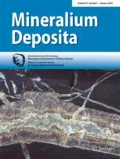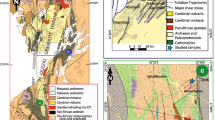Abstract
Talc mineralisation occurs as hematite–talc schist between soft hematite ore and dolomitic itabirite at Gongo Soco, Quadrilátero Ferrífero of Minas Gerais, Brazil. The hematite–talc schist and soft hematite have a prominent tectonic foliation of tabular hematite. Tabular hematite without preferential orientation is superimposed on the tectonic foliation. The talcose schist is enriched in F and has a constant Fe/S ratio. Electron-microprobe analyses indicate trace amounts of S in different generations of hematite. The whole-rock Fe/S ratio possibly represents sulfate S from hematite-hosted fluid inclusions. Fluid inclusions in foliation-overprinting hematite and chlorite geothermometry from talcose rocks suggest, respectively, temperatures from <200°C to ~300°C. Tourmaline, a rarely observed mineral in the hematite–talc schist, belongs to the alkali group and falls in the dravite compositional field. Boron-isotope determinations of tourmaline crystals, using secondary ion mass spectrometry, vary from −20‰ to −12‰ δ11B. This compositional isotopic range and the tourmaline chemical composition suggest a meta-evaporitic origin. A non-marine evaporitic setting is the most likely source of acidic, highly oxidising fluids, which resulted in the abundant F-bearing talc and the presence of otherwise immobile Ti in hematite. Oxidising brines were channelled along shear zones and converted dolomitic itabirite into the Gongo Soco soft hematite and the talc mineralisation. The latter is envisaged as the hydrothermal wall-rock alteration of dolomitic itabirite, which gave rise to the soft hematite ore.












Similar content being viewed by others
References
Alkmim FF, Marshak S (1998) Transamazonian orogeny in the southern São Francisco craton region, Minas Gerais, Brazil: evidence for Paleoproterozoic collision and collapse in the Quadrilátero Ferrífero. Precambr Res 90:29–58
Babinski M, Chemale F Jr, Van Schmus WR (1995) The Pb/Pb age of the Minas Supergroup carbonate rocks, Quadrilátero Ferrífero, Brazil. Precambr Res 72:235–245
Barth S (1993) Boron isotope variations in nature: a synthesis. Geol Rund 82:640–651
Cabral AR (2006) Palladiferous Gold Mineralisation (ouro preto) in Brazil: Gongo Soco, Itabira and Serra Pelada. Geologisches Jahrbuch, Sonderhefte Reihe D, Heft 8. E. Schweizerbart'sche Science Publishers, Stuttgart, p 115
Cabral AR, Rocha Filho OG, Jones RD (2003) Hydrothermal origin of soft hematite ore in the Quadrilátero Ferrífero of Minas Gerais, Brazil: petrographic evidence from the Gongo Soco iron ore deposit. Appl Earth Sci (Trans Inst Min Metall Sect B) 112:B279–B286
Cabral AR, Lehmann B, Galbiatti HF, Rocha Filho OG (2006) Evidence for metre-scale variations in hematite composition within the Palaeoproterozoic Itabira Iron Formation, Minas Gerais, Brazil. Mineral Mag 70:591–602
Cabral AR, Lehmann B, Tupinambá M, Schlosser S, Kwitko-Ribeiro R, de Abreu FR (2009) The platiniferous Au–Pd belt of Minas Gerais, Brazil, and genesis of its botryoidal Pt–Pd–Hg aggregates. Econ Geol 104:1265–1276
Cabral AR, Lehmann B, Tupinambá M, Wiedenbeck M, Brauns M (2011) Geology, mineral chemistry and tourmaline B isotopes of the Córrego Bom Sucesso area, southern Serra do Espinhaço, Minas Gerais, Brazil: implications for Au–Pd–Pt exploration in quartzitic terrain. J Geochem Expl. doi:10.1016/j.gexplo.2011.06.007
Cavalcanti JAD, Xavier RP (2006) Origem dos turmalinitos auríferos da região sudeste do Quadrilátero Ferrífero-MG: geologia, petrografia, química mineral e isótopos de Nd. Rev Bras Geociênc 36:646–647
Cook NDJ, Ashley PM (1992) Meta-evaporite sequence, exhalative chemical sediments and associated rocks in the Proterozoic Willyama Supergroup, South Australia: implications for metallogenesis. Precambr Res 56:211–226
Dalstra H, Guedes S (2004) Giant hydrothermal hematite deposits with Mg–Fe metasomatism: a comparison of the Carajás, Hamersley, and other iron ores. Econ Geol 99:1793–1800
Dorr JVN (1964) Supergene iron ores of Minas Gerais, Brazil. Econ Geol 59:1203–1240
Dorr JVN (1969) Physiographic, stratigraphic and structural development of the Quadrilátero Ferrífero, Minas Gerais, Brazil. US Geol Surv Prof Pap 641-A
Dyar MD, Wiedenbeck M, Robertson D, Cross LR, Delaney JS, Ferguson K, Francis CA, Grew ES, Guidotti CV, Hervig RL, Hughes JM, Husler J, Leeman W, McGuire AV, Rhede D, Rothe H, Paul RL, Richards I, Yates M (2001) Reference minerals for microanalysis of light elements. Geostandards Newsletter 25:441–463
Eichler J (1967) Das physikalisch-chemische Milieu bei der Verwitterung von Itabiriten in Minas Gerais/Brasilien. Chem Erde 26:119–132
Freeze RA, Cherry JA (1979) Groundwater. Prentice-Hall, Englewood Cliffs, p 604
von Freyberg B (1934) Die Bodenschätze des Staates Minas Geraes (Brasilien). E. Schweizerbart’sche Verlagsbuchhandlung, Stuttgart, p 453
Garda GM, Xavier RP, Cavalcanti JAD, Trumbull RB, Wiedenbeck M (2010) Significance of compositional and boron isotope variations in tourmaline of Passagem de Mariana gold mine, Quadrilátero Ferrífero, Minas Gerais, Brazil. Acta Mineral-Petrogr Abst Ser 6:483
Garnier V, Ohnenstetter D, Giuliani G (2004) L'aspidolite fluorée: rôle des évaporites dans la genèse du rubis des marbres de Nangimali (Azad-Kashmir, Pakistan). C R Geosci 336:1245–1253
Gonfiantini R, Tonarini S, Gröning M, Adorni-Braccesi A, Al-Ammar AS, Astner M, Bächler S, Barnes RM, Bassett RL, Cocherie A, Deyhle A, Dini A, Ferrara G, Gaillardet J, Grimm J, Guerrot C, Krähenbühl U, Layne G, Lemarchand D, Meixner A, Northington DJ, Pennisi M, Reitznerová E, Rodushkin I, Sugiura N, Surberg R, Tonn S, Wiedenbeck M, Wunderli S, Xiao Y, Zack T (2003) Intercomparison of boron isotope and concentration measurements. Part II: evaluation of results Geostandards Newsletter 27:41–57
Guimarães D (1953) Notas à margem da crítica. Instituto de Tecnologia Industrial, Estado de Minas Gerais, Belo Horizonte, Avulso 16
Harder EC, Chamberlin RT (1915) The geology of central Minas Gerais, Brazil. J Geol 23:341–378, 385–424
Hartmann LA, Endo I, Suita MTF, Santos JOS, Frantz JC, Carneiro MA, McNaughton NJ, Barley ME (2006) Provenance and age delimitation of Quadrilátero Ferrífero sandstones based on zircon U–Pb isotopes. J South Am Earth Sci 20:273–285
Henry DJ, Sun H, Slack JF, Dutrow BL (2008) Tourmaline in meta-evaporites and highly magnesian rocks: perspectives from Namibian tourmalinites. Eur J Mineral 20:889–904
Henwood WJ (1871) On the gold mines of Minas Geraes, in Brazil. Trans R Geol Soc Cornwall 8:168–370
Herz N (1978) Metamorphic rocks of the Quadrilátero Ferrífero, Minas Gerais, Brazil. US Geol Surv Prof Pap 641-C
Hippertt J, Davis B (2000) Dome emplacement and formation of kilometre-scale synclines in a granite–greenstone terrain (Quadrilátero Ferrífero, southeastern Brazil). Precambr Res 102:99–121
Koglin N, Frimmel HE, Minter WEL, Brätz H (2010) Trace-element characteristics of different pyrite types in Mesoarchaean to Palaeoproterozoic placer deposits. Miner Deposita 45:259–280
Kranidiotis P, MacLean WH (1987) Systematics of chlorite alteration at the Phelps Dodge massive sulfide deposit, Matagami, Quebec. Econ Geol 82:1898–1911
Lacourt F (1938) Baritita e pirita no município de Ouro Preto, Minas Gerais. Mineração e Metallurgia 3:298–301
Leeman WP, Tonarini S (2001) Boron isotopic analyses of proposed borosilicate mineral reference samples. Geostandards Newsletter 25:399–403
Lima TAF, Rios FJ, Meireles HP, Yardley B (2009) Fe-ore forming fluids in the Espinhaço Supergroup, Minas Gerais, Brazil. In: Williams PJ (ed) Smart science for exploration and mining. James Cook University, Townsville, Australia, pp 564–566
Lüders V, Romer RL, Cabral AR, Schmidt C, Banks DA, Schneider J (2005) Genesis of itabirite-hosted Au–Pd–Pt-bearing hematite-(quartz) veins, Quadrilátero Ferrífero, Minas Gerais, Brazil: constraints from fluid inclusion infrared microthermometry, bulk crush-leach analysis and U–Pb systematics. Miner Deposita 40:289–306
Meyer C, Wunder B, Meixner A, Romer RL, Heinrich W (2008) Boron-isotope fractionation between tourmaline and fluid: an experimental re-investigation. Contrib Mineral Petrol 156:259–267
Noce CM (2000) Geochronology of the Quadrilátero Ferrífero: a review. Geonomos 8:15–23
Palmer MR, Slack JF (1989) Boron isotopic composition of tourmaline from massive sulfide deposits and tourmalinites. Contrib Mineral Petrol 103:434–451
Palmer MR, London D, Morgan VIGB, Babb HA (1992) Experimental determination of fractionation of 11B/10B between tourmaline and aqueous vapor: a temperature- and pressure-dependent isotopic system. Chem Geol 101:123–129
Pires FRM (1995) Textural and mineralogical variations during metamorphism of the Proterozoic Itabira Iron Formation in the Quadrilátero Ferrífero, Minas Gerais, Brazil. An Acad Bras Ci 67:77–105
Rapp JF, Klemme S, Butler IB, Harley SL (2010) Extremely high solubility of rutile in chloride and fluoride-bearing metamorphic fluids: an experimental investigation. Geol 38:323–326
Rosière CA, Rios FJ (2004) The origin of hematite in high-grade iron ores based on infrared microscopy and fluid inclusion studies: the example of the Conceição mine, Quadrilátero Ferrífero, Brazil. Econ Geol 99:611–624
Rosière CA, Rios FJ (2006) Specularitic iron ores and shear zones in the Quadrilátero Ferrífero District. Appl Earth Sci (Trans Inst Min Metal B) 115:B134–B138
Rosière CA, Spier CA, Rios FJ, Suckau VE (2008) The itabirites of the Quadrilátero Ferrífero and related high-grade iron ore deposits: an overview. Rev Econ Geol 15:223–254
Samson IM, Banks DA (1988) Epithermal base-metal vein mineralization in the Southern Uplands of Scotland: nature and origin of the fluids. Miner Deposita 23:1–8
Slack JF, Palmer MR, Stevens BPJ, Barnes RG (1993) Origin and significance of tourmaline-rich rocks in the Broken Hill district, Australia. Econ Geol 88:505–541
Spier CA, de Oliveira SMB, Rosière CA (2003) Geology and geochemistry of the Águas Claras and Pico iron mines, Quadrilátero Ferrífero, Minas Gerais, Brazil. Miner Deposita 38:751–774
Spier CA, de Oliveira SMB, Sial AN, Rios FJ (2007) Geochemistry and genesis of the banded iron formations of the Cauê Formation, Quadrilátero Ferrífero, Minas Gerais, Brazil. Precambr Res 152:170–206
Tonarini S, Pennisi M, Adorni-Braccesi A, Dini A, Ferrara G, Gonfiantini R, Wiedenbeck M, Gröning M (2003) Intercomparison of boron isotope concentration measurements. Part I: Selection, preparation and homogeneity tests of the intercomparison materials. Geostandards Newsletter 27:21–39
Vial DS, Duarte BP, Fuzikawa K, Vieira MBH (2007) An epigenetic origin for the Passagem de Mariana gold deposit, Quadrilátero Ferrífero, Minas Gerais, Brazil. Ore Geol Rev 32:596–613
Warren JK (2006) Evaporites: Sediments, Resources and Hydrocarbons. Springer, Berlin, p 1035
Wiedenbeck M, Rhede D, Lieckefett R, Witzki H (2004) Cryogenic SIMS and its applications in the earth sciences. Appl Surf Sci 231–232:888–892
Acknowledgements
We gratefully acknowledge numerous visits to the Gongo Soco mine, initially under Mineração Socoimex, now operated by Companhia Vale do Rio Doce (VALE). Vagner Costa and Douglas José de Oliveira (VALE) are particularly thanked for logistical support and access to internal files. ARC expresses his gratitude to Prof. G. Beaudoin and Prof. B. Lehmann for access to the electron-microprobe facility at Université Laval and TU Clausthal, respectively. Reviews by two anonymous referees, as well as comments by Nikola Koglin, have greatly improved the manuscript.
Author information
Authors and Affiliations
Corresponding author
Additional information
Editorial handling: R. Perez Xavier
Electronic Supplementary Materials
Below is the link to the electronic supplementary material.
Table 1
Electron-microprobe analyses of carbonate from fresh wall-rock itabirite (DOC 41 kb)
Table 2
Electron-microprobe analyses of chlorite from fresh wall-rock itabirite and hematite–talc schist (DOC 58 kb)
Table 3
Electron-microprobe analyses of talc from hematite–talc schist (DOC 46 kb)
Table 4
Electron-microprobe analyses for trace elements in hematite (DOC 46 kb)
Table 5
Electron-microprobe analyses of tourmaline from hematite–talc schist (DOC 70 kb)
Table 6
Whole-rock chemical analyses of hematite–talc schist and dolomite (DOC 84 kb)
Table 7
Boron-isotope ratios of tourmaline from hematite–talc schist (DOC 34 kb)
Rights and permissions
About this article
Cite this article
Cabral, A.R., Wiedenbeck, M., Rios, F.J. et al. Talc mineralisation associated with soft hematite ore, Gongo Soco deposit, Minas Gerais, Brazil: petrography, mineral chemistry and boron-isotope composition of tourmaline. Miner Deposita 47, 411–424 (2012). https://doi.org/10.1007/s00126-011-0374-3
Received:
Accepted:
Published:
Issue Date:
DOI: https://doi.org/10.1007/s00126-011-0374-3




